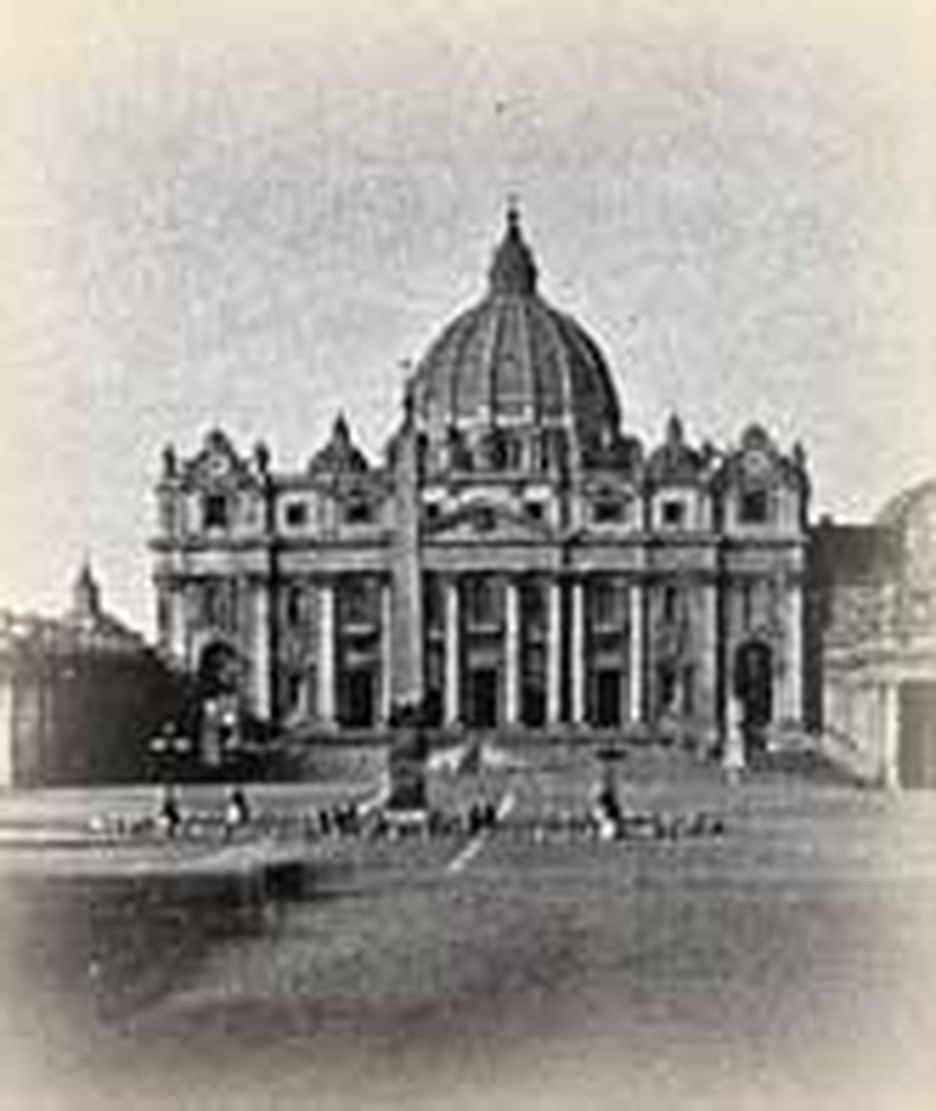
The walls of the old church were veined with cracks. Might it not collapse and kill the worshippers within? Nicholas V thought so. He summoned two famous architects with orders to strengthen the historic building. Alberti and Rossellino looked it over and came up with a plan for new walls.
St. Peter's basilica, first constructed by Constantine the Great, was to be shored up. It sat on the site where tradition says Peter was buried when executed in 67 A. D. As early as 90 A. D. an oratory had memorialize the spot. The work was just begun when Nicholas died. Succeeding popes let the project lapse.
Not until Julius II became pope was the project revived. Julius threw out halfway measures, determined to replace the basilica completely. As architect, he appointed Bramante. Bramante drew up huge plans and outraged traditionalists by rudely ripping down the old building. He should at least have disassembled the old columns, they sputtered, to be reused. Bramante went ahead with excavation.
On this date April 11, 1506, Pope Julius laid the foundation stone. The elderly vicar descended deep into the earth on a wobbly rope ladder to perform the honor. Lack of funds slowed construction. Leo X replaced Julius in 1513 and after Bramante's death in 1514 made Raphael the chief architect.
Work progressed slowly, due to lack of funds. Raphael never completed the project. Sangello, Verone, Sangallo and Peruzzi also served as architects at one time or another. Eventually Michelangelo was put in charge. He was then in his seventies, but redrew the plans. By the time he died in 1564, the shell of the dome was complete.
The great cathedral was not finished until 1626, 120 years after Julius laid the first stone. Then Carlo Maderna completed the facade. Men in those times projected their schemes across centuries. It is one of the most admirable characteristics of the church which confidently expected the body of Christ to survive all ups and downs. Neither Bramante's plans nor Michelangelo's were adhered to. Consequently the finished building was a series of compromises. Despite this it came forth with grandeur, its vast interior gloriously decorated. It covers four acres. St. Peter, who admired Herod's great temple in Jerusalem and preached and healed in it, might have been astonished at this triumph of religious architecture.
It was to pay for Raphael's efforts, by the way, that Leo X authorized the indulgence which led to Luther's 95 theses. Unfortunately, the edifice which sums up Catholic tradition and its patronage of the arts became a cause of the second greatest division in Christendom (the first being the East-West split in 1054) when Luther insisted indulgences were not necessary for Christians who can go directly to their Savior for forgiveness.
Bibliography:
- Bainton, Roland H. Here I Stand. New York: Mentor, 1950.
- Begni, Ernesto. Vatican; Its history--its treasures. New York: Letters and Arts, 1914.
- Brusher, J. Popes Through the Ages. Princeton, New Jersey: Van Nostrand, 1964.
- Durant, Will. The Renaissance, New York: Simon and Schuster, 1953; pp. 450 - 451.
- "Indulgences." New Schaff-Herzog Encyclopedia of Religious Knowledge. Grand Rapids: Baker Book House, 1954.
- "Indulgences." The Oxford encyclopedia of the Reformation. Editor in chief Hans J. Hillerbrand. New York: Oxford University Press, 1996.
- Kent, W. H. "Indugences." The Catholic Encyclopedia. New York: Robert Appleton, 1914.
- "Julius II." The Oxford Dictionary of the Christian Church. Edited by F. L. Cross and E. A. Livingstone. Oxford, 1997.
- Maus, Cynthia Pearl. Christ and the Fine Arts. New York: Harper and Brothers, 1959, 1938.
- Montor, Artaud de. The Lives and Times of the Popes. New York: The Catholic publication society of America, 1910 - 11.
- Ott, Michael. "Julius II." The Catholic Encyclopedia. New York: Robert Appleton, 1914.
- Various encyclopedia articles.
Last updated April, 2007.
.jpg)

.jpg)
